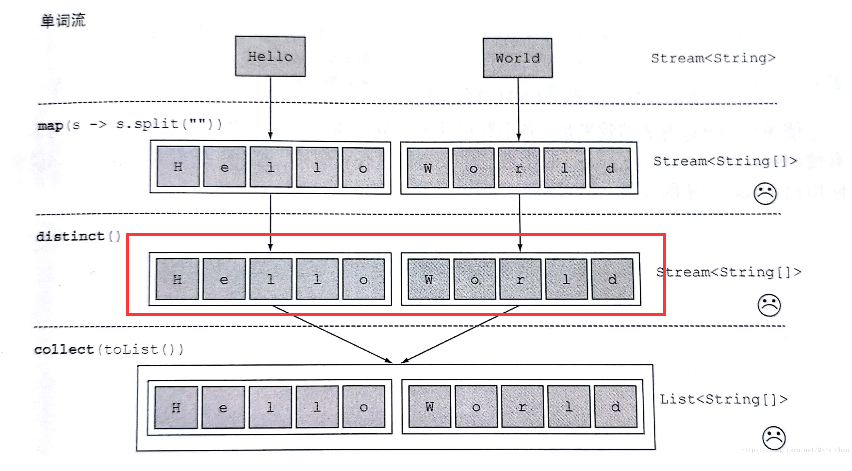java8 stream编程
说明:这是基于同事的培训材料做的练习,记录下来,以作日后自己coding分析和改进
1.准备
pom.xml
<dependency>
<groupId>org.apache.commons</groupId>
<artifactId>commons-collections4</artifactId>
<version>4.1</version>
</dependency>
<dependency>
<groupId>com.google.guava</groupId>
<artifactId>guava</artifactId>
<version>14.0</version>
</dependency>
Dish.java
package com.example.demo; import lombok.AllArgsConstructor;
import lombok.Data; /**
* Created by Administrator on 2019/9/7.
*/
@Data
@AllArgsConstructor
public class Dish {
private int calories;
private String name; }
List<Dish> list;
list = Lists.newArrayList(
new Dish( 1,"aa"),
new Dish(13,"bb"),
new Dish(7,"cc"),
new Dish( 6,"aa"),
new Dish(9,"dd"),
new Dish(1,"ee"),
new Dish( 3,"aa"),
new Dish(1,"ff"),
new Dish(1,"gg")
);
2.stream的创建
Integer[] ints={1,2};
List<Integer> list2=Lists.newArrayList(ints);
List<String> collect3 = list2.stream().map(o -> "1" + o).collect(Collectors.toList());
List<String> collect4 = Stream.of(1,2).map(o -> "1" + o).collect(Collectors.toList());
List<String> collect5 = Stream.of(ints).map(o -> "1" + o).collect(Collectors.toList());
List<String> collect6 = Stream.of(list2).map(o -> "1" + o).collect(Collectors.toList());
System.out.println(collect3);
System.out.println(collect4);
System.out.println(collect5);
System.out.println(collect6);
输出:
[11, 12]
[11, 12]
[11, 12]
[1[1, 2]]
3.list转map并排序
list排序参照java8排序 java8 list转Map报错Collectors.toMap :: results in "Non-static method cannot be refernced from static context"
TreeMap<String, String> collect1 = list.stream()
.collect(Collectors.toMap(Dish::getName, o -> "", (key1, key2) -> key2, TreeMap<String, String>::new)); //Map中的value自己o->o或者Function.identity()
System.out.println(collect1);
输出:{aa=, bb=, cc=, dd=, ee=, ff=, gg=}
4.list转linkedList
LinkedList<Dish> collect2 = list.stream().collect(Collectors.toCollection(LinkedList::new));
输出:[Dish(calories=1, name=aa), Dish(calories=13, name=bb), Dish(calories=7, name=cc), Dish(calories=6, name=aa), Dish(calories=9, name=dd), Dish(calories=1, name=ee), Dish(calories=3, name=aa), Dish(calories=1, name=ff), Dish(calories=1, name=gg)]
5.filter筛选,map映射,sorted排序,limit截断流,collect的使用
List<String> collect = list.stream()
.filter(d ->d.getCalories() < 9)
.sorted(Comparator.comparing(Dish::getCalories).reversed())
.map(d->d.getName())
.limit(3)
输出:[cc, aa, aa]
打印日志:
List<String> collect = list.stream()
.filter(d ->{
System.out.println("filter "+d.getName());
return d.getCalories() < 9;})
.sorted(Comparator.comparing(Dish::getCalories).reversed())
.map(d->{
System.out.println("map "+d.getName());
return d.getName();
})
.limit(3)
.collect(Collectors.toList());
System.out.println(collect);
输出:
filter aa
filter bb
filter cc
filter aa
filter dd
filter ee
filter aa
filter ff
filter gg
map cc
map aa
map aa
[cc, aa, aa]
//不排序
Stream在迭代的时候称为内部迭代,会进行一系列的优化,并不会将前面的执行完再进行后面的操作,它会进行全面的评估,执行最优迭代,前面的操作都不会执行,直到最后的collect方法调用时,这称为惰性执行.(你在某些情况下甚至可以使用parallelStream(),它会根据你cpu核数并行计算.)
List<Dish> list;
list = Lists.newArrayList(
new Dish( 1,"aa"),
new Dish(13,"bbc"),
new Dish(7,"cc"),
new Dish( 6,"aa"),
new Dish(9,"dd"),
new Dish(1,"ee"),
new Dish( 3,"aa"),
new Dish(1,"ff"),
new Dish(1,"gg")
);
List<String> collect = list.stream()
.filter(d ->{
System.out.println("filter "+d.getName());
return d.getCalories() < 9;})
// .sorted(Comparator.comparing(Dish::getCalories).reversed())
.map(d->{
System.out.println("map "+d.getName());
return d.getName();
})
.limit(3)
.collect(Collectors.toList()); System.out.println(collect);
输出:
filter aa
map aa
filter bbc
filter cc
map cc
filter aa
map aa
[aa, cc, aa]
比如:这里filter只进行了4次就找够了,map也只进行了三次,他们是并行进行的
6.skip,distinct,flatMap的使用
//distinct
List<String> collect7 = list.stream().map(Dish::getName).distinct().collect(Collectors.toList());
System.out.println(collect7);
输出:[aa, bb, cc, dd, ee, ff, gg]
//skip
List<String> collect7 = list.stream().map(Dish::getName).distinct().skip(3).collect(Collectors.toList());
System.out.println(collect7);
输出:[dd, ee, ff, gg]
//Map
String[] words=new String[]{"hello","world"};
List<String[]> collect8 = Arrays.stream(words).map(w -> w.split(""))
.distinct()
.collect(Collectors.toList());
System.out.println(JSONObject.toJSONString(collect8));
输出:[["h","e","l","l","o"],["w","o","r","l","d"]]

//flatmap对流扁平化处理
List<String> collect8 = Arrays.stream(words).map(w -> w.split(""))
.flatMap(Arrays::stream)
.distinct()
.collect(Collectors.toList());
System.out.println(JSONObject.toJSONString(collect8));
输出:["h","e","l","o","w","r","d"]

7.终结操作:
7.1 匹配anyMatch,allMatch,oneMatch
anyMatch,只有找到第一个匹配的就退出并返回true
if(Stream.of(9,5,8,6,5,9,8,3,1,0,8,2).anyMatch(o->o==8)){
System.out.println("find the item");
};
输出:find the item
allMatch,匹配所有元素才返回true
if(Stream.of(9,5,8,6,5,9,8,3,1,0,8,2).allMatch(o->o==8)){
System.out.println("success");
}else {
System.out.println("failure");
};
输出:failure
noneMatch,所有元素都不匹配才返回true,否则false
if(Stream.of(9,5,8,6,5,9,8,3,1,0,8,2).noneMatch(o->o==11)){
System.out.println("success");
}else {
System.out.println("failure");
};
输出:false
7.2查找findAny,findFirst
findAny,返回任意一个,注意是否为null的判断,关于Optional参考理解、学习与使用 Java 中的 Optional
Optional<Integer> any = Stream.of(9, 5, 8, 6, 5, 9, 8, 3, 1, 0, 8, 2).filter(o -> o < 2).findAny();
if(any.isPresent())
System.out.println(any.get());
输出:1
findFirst,找到第一个符合条件的,如找到第一个平方能被4整除的值
Optional<Integer> any = Stream.of(9, 5, 8, 6, 5, 9, 8, 3, 1, 0, 8, 2).map(o->o*o).filter(o -> o%4==0).findAny();
if(any.isPresent())
System.out.println(any.get());
输出:64
相比于findAny,findFirst在并行上有更多的限制,如果不关心找到哪个元素,推荐用findAny。与limit(1)不同,它们是终结操作,不需要collect
8.归约操作
8.1求和(广义归约)
归约操作是指将流中的所有元素反复组合起来,得到一个值。比如,将流中的元素求和:int sum = numbers.stream().reduce(0, (a, b) -> a + b);为什么说是反复组合起来?
求和归约操作中是将指定的初始值0(reduce方法的第一个参数)与流中的第一个元素相加(表达为reduce的第二个参数BinaryOperator,我们传递是Lambda表达式(a, b) -> a + b)得到一个中间值后与流中的第二个元素相加,直至流中的所有元素都被累加完,得到最终的求和结果。
Integer reduce = Stream.of(9, 5, 8, 6, 5, 9, 8, 3, 1, 0, 8, 2).reduce(, (a, b) -> a + b);
System.out.println(reduce);//
只传一个参数
Optional<Integer> reduce = Stream.of(9, 5, 8, 6, 5, 9, 8, 3, 1, 0, 8, 2).reduce((a, b) -> a + b);
if(reduce.isPresent())
System.out.println(reduce.get());//64
也可以这样
Optional<Integer> reduce = Stream.of(9, 5, 8, 6, 5, 9, 8, 3, 1, 0, 8, 2).reduce(Integer::sum);
if(reduce.isPresent())
System.out.println(reduce.get());//64
也可以
Integer collect9 = list.stream().collect(Collectors.reducing(0,//初始值
Dish::getCalories, //转换函数
Integer::sum));//累积函数
System.out.println(collect9);//42
预定义归约:
Integer collect9 = list.stream().collect(Collectors.summingInt(Dish::getCalories));
System.out.println(collect9);
更简洁的用法:
int sum = Stream.of(9, 5, 8, 6, 5, 9, 8, 3, 1, 0, 8, 2).mapToInt(Integer::intValue).sum();
System.out.println("sum===="+sum);//sum====42
8.2求最大值
Optional<Integer> reduce = Stream.of(9, 5, 8, 6, 5, 9, 8, 3, 1, 0, 8, 2).reduce(Integer::max);
if(reduce.isPresent())
System.out.println(reduce.get());//9
也可以
Optional<Dish> collect9 = list.stream().collect(Collectors.maxBy(Comparator.comparing(Dish::getCalories)));
Optional<Dish> collect10 = list.stream().max(Comparator.comparing(Dish::getCalories));
if(collect9.isPresent())
System.out.println(collect9.get());//Dish(calories=13, name=bb)
8.3求最小值
Optional<Integer> reduce = Stream.of(9, 5, 8, 6, 5, 9, 8, 3, 1, 0, 8, 2).reduce(Integer::min);
if(reduce.isPresent())
System.out.println(reduce.get());//0
8.4其它归约函数count
Long collect9 = list.stream().collect(Collectors.counting());
long count = list.stream().count();
System.out.println(collect9);
8.5 join连接
String collect11 = list.stream().map(Dish::getName).collect(Collectors.joining());
System.out.println(collect11);//aabbccaaddeeaaffgg
String collect12 = list.stream().map(Dish::getName).collect(Collectors.joining("--", "start:", ":end"));
System.out.println(collect12);//start:aa--bb--cc--aa--dd--ee--aa--ff--gg:end
8.6 groupingBy
Map<String, List<Dish>> collect13 = list.stream().collect(Collectors.groupingBy(Dish::getName));
System.out.println(JSONObject.toJSONString(collect13));
System.out.println(JSONObject.toJSONString(list));
输出:
{"gg":[{"calories":1,"name":"gg"}],"ff":[{"calories":1,"name":"ff"}],"ee":[{"calories":1,"name":"ee"}],"dd":[{"calories":9,"name":"dd"}],"cc":[{"calories":7,"name":"cc"}],"bb":[{"calories":13,"name":"bb"}],"aa":[{"calories":1,"name":"aa"},{"calories":6,"name":"aa"},{"calories":3,"name":"aa"}]}
[{"calories":1,"name":"aa"},{"calories":13,"name":"bb"},{"calories":7,"name":"cc"},{"calories":6,"name":"aa"},{"calories":9,"name":"dd"},{"calories":1,"name":"ee"},{"calories":3,"name":"aa"},{"calories":1,"name":"ff"},{"calories":1,"name":"gg"}]
只要统计个数
Map<String, Long> collect13 = list.stream().collect(Collectors.groupingBy(Dish::getName, Collectors.counting()));
System.out.println(JSONObject.toJSONString(collect13));
输出:{"gg":1,"ff":1,"ee":1,"dd":1,"cc":1,"bb":1,"aa":3}
9并行执行
int sum = Stream.of(9, 5, 8, 6, 5, 9, 8, 3, 1, 0, 8, 2).parallel().mapToInt(Integer::intValue).sum();
System.out.println("sum===="+sum);//42
数据并行处理,只需要在原来的基础上加一个parallel()就可以开启~。顺便提一下这里parallel()开启的底层并行框架是fork/join,默认的并行数是Ncpu个。
java8 stream编程的更多相关文章
- 关于Java8函数式编程你需要了解的几点
函数式编程与面向对象的设计方法在思路和手段上都各有千秋,在这里,我将简要介绍一下函数式编程与面向对象相比的一些特点和差异. 函数作为一等公民 在理解函数作为一等公民这句话时,让我们先来看一下一种非常常 ...
- Java8 函数式编程详解
Java8 函数式编程详解 Author:Dorae Date:2017年11月1日23:03:26 转载请注明出处 说起Java8,可能很多人都已经知道其最大的改进,就是引入了Lambda表达式与S ...
- java8 Stream的实现原理 (从零开始实现一个stream流)
1.Stream 流的介绍 1.1 java8 stream介绍 java8新增了stream流的特性,能够让用户以函数式的方式.更为简单的操纵集合等数据结构,并实现了用户无感知的并行计算. 1.2 ...
- Java8函数式编程探秘
引子 将行为作为数据传递 怎样在一行代码里同时计算一个列表的和.最大值.最小值.平均值.元素个数.奇偶分组.指数.排序呢? 答案是思维反转!将行为作为数据传递. 文艺青年的代码如下所示: public ...
- 简洁又快速地处理集合——Java8 Stream(下)
上一篇文章我讲解 Stream 流的基本原理,以及它与集合的区别关系,讲了那么多抽象的,本篇文章我们开始实战,讲解流的各个方法以及各种操作 没有看过上篇文章的可以先点击进去学习一下 简洁又快速地处理集 ...
- [2017.02.23] Java8 函数式编程
以前学过Haskell,前几天又复习了其中的部分内容. 函数式编程与命令式编程有着不一样的地方,函数式编程中函数是第一等公民,通过使用少量的几个数据结构如list.map.set,以及在这些数据结构上 ...
- Java8 Stream新特性详解及实战
Java8 Stream新特性详解及实战 背景介绍 在阅读Spring Boot源代码时,发现Java 8的新特性已经被广泛使用,如果再不学习Java8的新特性并灵活应用,你可能真的要out了.为此, ...
- 【转】Java8 Stream 流详解
当我第一次阅读 Java8 中的 Stream API 时,说实话,我非常困惑,因为它的名字听起来与 Java I0 框架中的 InputStream 和 OutputStream 非常类似.但是 ...
- 《Java8 Stream编码实战》正式推出
当我第一次在项目代码中看到Stream流的时候,心里不由得骂了一句"傻X"炫什么技.当我开始尝试在代码中使用Stream时,不由得感叹真香. 记得以前有朋友聊天说,他在代码中用了 ...
随机推荐
- python模块导入总结
python模块导入总结 模块导入方式 定义test.py模块 def print_func(): print("hello") import 语句 导入模块语法 import m ...
- KVM安装配置笔记
系统环境centos6.6 一.KVM安装前系统相关操作: (1)修改内核模式为兼容内核启动 # grep -v "#" /etc/grub.confdevice (hd0) HD ...
- java中too many characters in character literal
IDE里发现 too many characters in character literal 翻译过来就是 字符中的字符过多 , 一般情况是:把 多个文字 放在了 '' (单引号)里,应该放到 &q ...
- ipcs - 提供基于 ipc (Inter-process communication)结构的信息
总览 ipcrm [ shm | msg | sem ] id 描述 ipcrm 将删除指定的资源--指定 id.
- 01.LNMP架构-Nginx源码包编译部署详细步骤
操作系统:CentOS_Server_7.5_x64_1804.iso 部署组件:Pcre+Zlib+Openssl+Nginx 操作步骤: 一.创建目录 [root@localhost ~]# mk ...
- 【原】iptables 交叉编译
防火墙在做数据包过滤决定时,有一套遵循和组成的规则,这些规则存储在专用的数据包过滤表中,而这些表集成在 Linux 内核中.在数据包过滤表中,规则被分组放在我们所谓的链(chain)中.而netfil ...
- celery源码解读
Celery启动的入口: 文件:Celery/bin/celery.py 看下main函数做了什么事 可以看到主要做了几个事根据-P参数判断是否需要打patch,如果是gevent或者eventlet ...
- 机器学习四 SVM
目录 引言 SVM 线性可分SVM 线性不可分SVM Hinge Loss 非线性SVM 核函数 总结 参考文献 引言 在深度神经网终(Deep Neural Network, DNN) 大热之前, ...
- 25.复杂链表的复制(python)
题目描述 输入一个复杂链表(每个节点中有节点值,以及两个指针,一个指向下一个节点,另一个特殊指针指向任意一个节点),返回结果为复制后复杂链表的head.(注意,输出结果中请不要返回参数中的节点引用,否 ...
- vue项目中监听sessionStorage值发生变化
首先在main.js中给Vue.protorype注册一个全局方法, 其中,我们约定好了想要监听的sessionStorage的key值为’watchStorage’, 然后创建一个StorageEv ...
